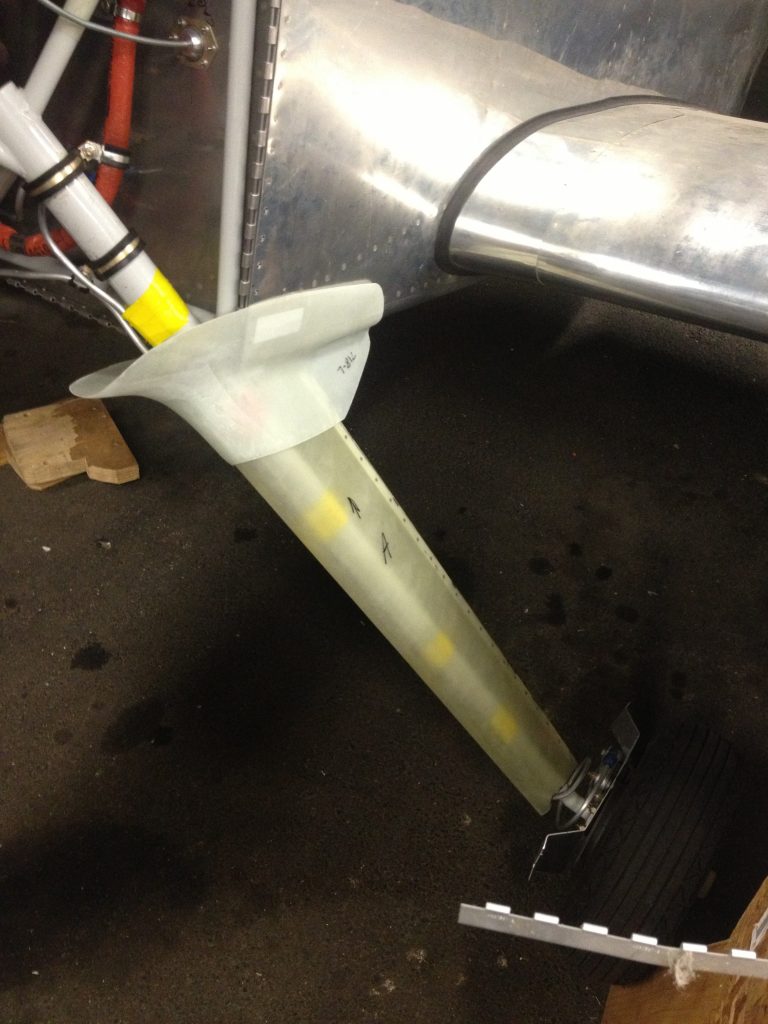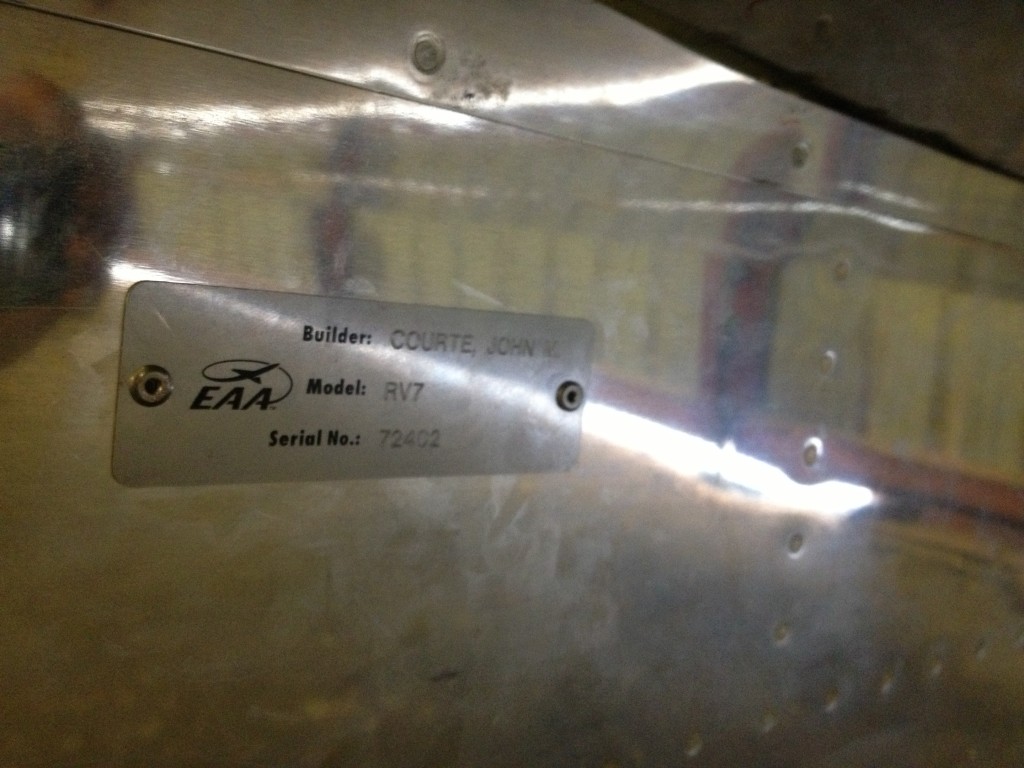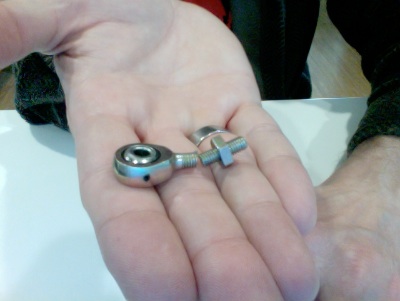4 hours.
“Not a creature was stirring, save this rivet banger…”
This encompasses Saturday through Monday.
With the holidays in full swing, the schedule gets a little weird, but better, because I have a few days off. I’m keeping a decent balance between building, home obligations, holiday festivities, and the occasional video game. I’m also coming to terms with the fact that the endgame for this project is approaching rapidly, or so it seems to me. Last weekend, I’d started on the gear leg fairings. This weekend, I pretty much got them done.
The most important thing with the gear leg fairings is to build them without any twist in them. They come taped together from the factory, but Van’s fiberglass is usually so crappy for fit, I didn’t trust them. The way you verify no twist is to put the leading edge on a flat surface and using a square, insure that both trailing edges line up. Once that’s done, you can use the full-scale template cut from the plans to mark all the cut lines. Easier said than done, though. You really need two squares, one for each end, and another pair of hands, or at least a boatload of tape. But I found a solution in our hangar that worked very nicely:
 That brass thing is a piece of channel from one of those godawful floor-to-ceiling mirrored sliding doors, usually found in cheesy SoCal apartments that saw their last renovation some time before Saddam Hussein rolled his tanks into Kuwait City. But it makes a very nice, very straight jig for lining up the trailing edges of the gear leg fairings. Not only that, it provides an excellent platform for match-drilling the hinges. Some of you are looking at this and saying “hey, those are the wrong size hinges!” Yes they are. But it’s what I had. I used up all my 1/16″ piano hinge on various attempts at the cowl. If it should come to pass that these hinges cost me knots and fuel, I’ll change them out, but at this point, I want to be done.
That brass thing is a piece of channel from one of those godawful floor-to-ceiling mirrored sliding doors, usually found in cheesy SoCal apartments that saw their last renovation some time before Saddam Hussein rolled his tanks into Kuwait City. But it makes a very nice, very straight jig for lining up the trailing edges of the gear leg fairings. Not only that, it provides an excellent platform for match-drilling the hinges. Some of you are looking at this and saying “hey, those are the wrong size hinges!” Yes they are. But it’s what I had. I used up all my 1/16″ piano hinge on various attempts at the cowl. If it should come to pass that these hinges cost me knots and fuel, I’ll change them out, but at this point, I want to be done.

A selfie, checking the alignment of the hinge.
With those done, I could check out the fit of my intersection fairings.

Upper intersection fairing fits, sort of. It needs some work. It’ll also need to be taped into position to hug the contour of the fuse and cowl, and then a couple of layups on top of that. After that, it gets trimmed back to where it’s supposed to be. Van’s fiberglass may be crap, but it’s better than mine and it sure beats fiddling around with modeling clay.
Monday was all about tying up as many loose ends as I could before starting on the wheel pants. This meant, among other things, getting as ready for the inspection as possible. I attached the ‘EXPERIMENTAL’ sticker to the roll bar:

This is a bit redundant because the baggage bulkhead cover that came with the interior has it embroidered into the leather, but that won’t be installed during the inspection. The canopy frame covers this one up when the canopy is down, but I don’t think that matters. If it does, those stickers are cheap.

This is required by the Feds to be in the airplane in plain view of the occupants. It’s like a magic amulet to ward off the unadventurous.

Left Gear leg
Left Gear leg works much the same way.
After this, I spent some time doing odd jobs. I safety-wired the tailwheel chain hardware, then moved to the cockpit, where I zip-tied the wires made loose by the magneto troubleshooting and the addition of the OAT probe. I also attached bolts in the center section per Van’s SB 12-08-14. Apparently enough people forget this step that Van’s thought it merited a Service Bulletin. Guess what? I forgot it too. In addition to the close-tolerance bolts that hold the wing spars to the center section, there are two on each side that secure the center section to the vertical bar on the wing spar. These need some AN4 bolts in there to lock things down.
Part of getting airworthy is checking all the relevant SB’s and AD’s to make sure you don’t have anything hanging in the breeze that might kill you. The rules on experimental aircraft and AD’s are fuzzy, and are interpreted by various people in various ways, because different sections of the FAR’s appear to contradict each other. But the safe thing to do is check for AD’s and SB’s that apply to your stuff and fix them if you find any. If I hadn’t gone through this process, I wouldn’t have found those missing bolts and the inspector would have.
When I moved on to the engine, I discovered some oil running down from the spacer on the right mag and at the oil drain fitting of the #1 cylinder. This was alarming enough to merit a quick engine test. I cleaned off the oil and wheeled it out to start up, to verify that the oil was new and not left over from the last time I had to loosen them up to get to one thing or another.
I did a quick runup and brought the cht’s up to operating temperature, but even with good, timed mags, it still stumbled off idle. Advancing the throttle slowly would bring the RPM up, but moving it smartly, like I would for takeoff, killed the engine. After consulting VAF and then my AFP manual, it looks like my idle mixture is set too lean. This will need to be corrected, and I can probably do this tomorrow. The good news is that I didn’t see any new oil in the spots where I found the drips, so it looks like the oil around the mag spacer was from when I had the mags off, and the oil from the #1 drain line is from the time I had to undo the fitting at the cylinder head to get at either the bottom spark plug or the EGT probe.












